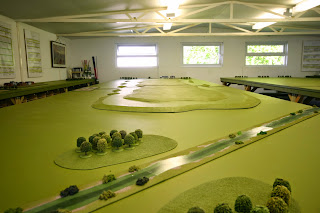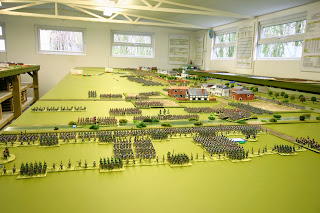The Southern end of the battlefield, with the stream and villages, has its own difficulties, primarily that a French force has to fight all day outnumbered by about 4 : 1.
The battle was split into 2 games as even my table is not big enough to fight the battle in one. I will assume that everyone roughly knows how the battle was fought and the key elements that influenced the battle and its outcome. I will just show some more piccies of the battles.
First the north.
The above is looking South along the Russian lines. If the table continued, the Pratzen would be in the distance. The key to this sector is the Olmutz road, the Allied lines of communications. You can just see it in the middle of the pic. The battle in this sector started after the fog had lifted and pitched forces against each other that were roughly equal in strength.
This pic is from the French lines, looking north. The hill is the Santon which was where Napoleon viewed the unveiling of his battle plan. The whole battlefield is relatively open. Both sides have two infantry divisions, the Russians from Bagration and the French from Lannes. Both sides also have their respective reserve cavalry formations.
This shows the French centre from the north with their massed cavalry. Both sides had infantry to the flanks not wanting to risk infantry in the centre with cavalry swirling everywhere.
This is the same view from the south
This is taken from behind the Allied centre where they have their massed cavalry. The French are in the background
This is late in the battle where the French infantry on the left most northern flank are making headway against the Allied right and are forcing it back. Needless to say, the game involved a lot of cavalry clashes which were always closely fought and would end in draws with neither side breaking. Quite historical really. We fought the game twice. The first game saw the Allies maintain the battlefield as they did historically, blunting the French advance. The second game saw the French have the advantage, not breaking the allies, but slowly pushing their whole line back. These were interesting games because of the amount of cavalry that took part and fought.
Rogues gallery, all regulars. The reason for the car, and its decoration, was that the Tour de Yorkshire would pass our house and village about 15 minutes after this pic was taken.
Now onto pics form the action on the southern front. The real problem with this game would be the heavy outnumbering of the French. I went with a fairly historic reflection of numbers and this would be a stringent test of the rules and the mechanisms for protracted village fighting. We needn't have worried. As a game it was superb, well balanced with each side biting their finger nails as to whether they would either hold on if you were French or breakthrough if you were allied. In the end, the French just held the line as Soult's attack up the Pratzen gathered pace.
This is Kobelnitz, towards the left of the French lines. It was defended by 3 Btns that were attacked by about 15. The battle would rage all day. The Russians eventually ejected the garrison, only to be immediately counter attacked by Soult's counter attack with 2 divisions angled up towards the Pratzen. Here the Russians are still holding one sector of the village, but their division is now wrecked!
This is the Pheasantry. This was defended by two principal Btns, the Tiraillers du Corses and the Tirailleurs du Po. The Russians would eventually force the defenders to the back of the Pheasantry and threaten its right flank as shown above, but the French would hold on with the help of close artillery support.
The church represented Sokolnitz castle, itself not threatened heavily. Just behind it is Sokolnitz village. This village would be subjected to probably no less than a dozen assaults by large Austrian columns. Losses were high and the defenders would only hang on by the scraps of their fingernails
This is taken from behind the allied line showing the struggle for the Pheasantry
This is one of Soult's divisions counter attacking. The Pratzen heights are out of picture to the front left and the village to the front right is Kobelnitz.
To the left flank of the previous division was the last of Soult's divisions attacking the Allied cavalry on their left flank. s the enemy cavalry was largely Hussar and Uhlan with some Cossacks, the French used infantry firepower to push them back. The allied cavalry would charge repeatedly to try and slow down the French, but to no avail, although they did manage to break one French column!!
The Austrian masses attacking Sokolnitz. The defenders only held out because Davout began to arrive behind Sokolnitz. Part of Davout's force was also sent to Tellnitz which was also struggling to hold out.
Soult has now forced back the allied cavalry on the French left flank. Soult, now supported by his own cavalry, is advancing onto the Pratzen where the Russian Guard has now deployed to face the new threat. At this point the game ended. The French line along the villages were now holding. Soult's division advancing on the Pratzen would likely undo the allied line by manoeuvre, whilst the division that was attacking Kobelnitz would roll up the allied line along the line of villages. Closely fought and very enjoyable.
Rogues gallery for this one. It was actually fought before the other game. All these battles are being written up and will be published in a companion series to the main rules. The first one is at the publishers, the 1809 Danube campaign. Full OBs, map, deployments, a battle commentary and loss assessment. Next battle here is Friedland, starting this weekend. More beer please!!
















Interesting to see such a large battle in this scale - you certainly have plenty of space! I look forward to seeing your next game.
ReplyDeleteLooks great Gerry, excellent in fact. The scope of the games is so impressive. Wondering why no one was in Lycra for the Tour photographs!
ReplyDeleteLycra does require a slim physique! I prefer to think I am growing, just like the size of the games!!
ReplyDeleteHa.. Table NOTbig enough! .... Blimey...
ReplyDeleteToo true Dave, too true!!
ReplyDelete